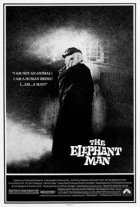
The Elephant Man Page #5
- PG
- Year:
- 1980
- 124 min
- 2,569 Views
OWNER:
Stand up!
The Boy, excited by his own fear, mimics the Owner.
BOY:
Stand up!
The figure comes forward and lets the blanket fall to the
ground and we see the ELEPHANT MAN himself.
Treves, his eyes wide with horror and wonder, his mouth frozen
open, steps backward in an instinctive movement of self
preservation.
The Owner laughs.
The Elephant Man is naked to the waist, his feet are bare
and he wears a pair of worn trousers from a fat man's dress
suit. He is a little below average height, and looks shorter
from the bowing of his back. His head is enormous and
misshapen, as big around as a man's waist. From his brow
projects a huge boney mass, almost obscuring his right eye.
His nose is a nose of flesh, recognizable only from its
position.
From the upper jaw projects another mass of bone protruding
from the mouth like a stump, turning the upper lip inside
out, making a slobbering aperture.
It almost gives the impression of a rudimentary trunk or
tusk. On top of his head is a handful of lank, black hair.
At the back of it hangs a bag of spongy skin, resembling
cauliflower. These loathsome growths cover his back and hang
down to the middle of his thighs. The right arm is enormous
and shapeless, the hand like a knot of tuberous roots. His
left arm is not only normal, but delicately shaped, with
fine skin and a hand that any woman might envy. From his
chest hangs another bag of flesh, like the dewlap of a lizard.
His legs are also grossly deformed, his feet great stumps.
Behind him, as painted in the portrait, are two crudely
constructed palm trees.
OWNER:
Turn around!
The Elephant Man begins to turn. The boy filled with malicious
glee at seeing the monster obey, screams.
BOY:
Turn around! Turn around!
The Elephant Man completes his turn and comes to rest.
We see a CLOSE-UP of the Elephant Man looking at Treves. His
face is utterly devoid, and incapable, of expression.
We see the Elephant Man's eyes. He closes them.
OUTSIDE THE SHOP
Treves, facing the street, drinks in the fresh air. He is
trying to forget his shock, put everything into focus.
He looks at the garish portrait again.
Treves produces his purse.
The Owner, smelling money, turns.
Treves hands him several coins.
TREVES:
So you'll bring him to me, tomorrow,
10:
00 a.m.? Mr...?OWNER:
Bytes. Mr. Bytes. He'll be there.
TREVES:
I'll send a cab. Here is my card.
Treves hands the Owner a card. The Owner, greasy and dirty,
shakes Treves' hand and squeezes his arm.
OWNER:
Now we got a deal... We understand
each other... guv. We understand
each other completely.
The Owner gives Treves the evil look of a conspirator.
Treves walks off, disoriented.
The Owner reads the card and smiles at Treves walking away
down the street.
A CABMAN is knocking on the door of the shop, staring at the
portrait. The door opens, revealing a figure in a floor-length
black cloak. On his head is an extremely large hat, cut to
the lines of a yachting cap. A grey-flannel curtain hangs
from the bottom of the cap all the way around, hiding his
face.
There is a horizontal slit in front for the eyes. On the
figure's feet are large, bag-like slippers. The only part of
the body seen at all is the left arm and hand, which protrudes
from the cloak, holding a crude walking stick.
The figure seems to loathe being in the open. We can just
barely see in the darkness within the Owner standing to one
side of the door, obviously enjoying the surprise on the
Cabman's face. The Owner steps abruptly into his view.
OWNER:
Don't just stand there. Help him up.
The Cabman, does so, while a small, curious crowd forms. The
Owner gives the Cabman the card. The Cabman jumps up onto
the seat and off they go.
THE RECEIVING ROOM - LONDON HOSPITAL
The receiving room is a bare hall, painted stone color. It
has rows of benches and a long desk where entries are made,
and certificates and other papers are issued. It is a cold,
harsh place.
CABMAN:
Not at all, sir. My... pleasure.
He exits.
Treves turns and sees the Matron, staring.
TREVES:
I'll be in my rooms, Mothershead.
I'm not to be disturbed.
She nods silently. Treves looks at the figure for a moment.
TREVES:
Come with me, please.
He starts to go out of the room. The hooded figure just stands
there, motionless.
We see the whole room, the people now silent. They all stare
at the figure.
No one makes a move.
MATRON:
You heard the doctor... Go on.
Treves turns to look at the hooded figure who stands there a
moment, then slowly shuffles after him. Mrs. Mothershead and
the people in the room watch him go. When he is out of sight,
they all begin to talk excitedly.
Translation
Translate and read this script in other languages:
Select another language:
- - Select -
- 简体中文 (Chinese - Simplified)
- 繁體中文 (Chinese - Traditional)
- Español (Spanish)
- Esperanto (Esperanto)
- 日本語 (Japanese)
- Português (Portuguese)
- Deutsch (German)
- العربية (Arabic)
- Français (French)
- Русский (Russian)
- ಕನ್ನಡ (Kannada)
- 한국어 (Korean)
- עברית (Hebrew)
- Gaeilge (Irish)
- Українська (Ukrainian)
- اردو (Urdu)
- Magyar (Hungarian)
- मानक हिन्दी (Hindi)
- Indonesia (Indonesian)
- Italiano (Italian)
- தமிழ் (Tamil)
- Türkçe (Turkish)
- తెలుగు (Telugu)
- ภาษาไทย (Thai)
- Tiếng Việt (Vietnamese)
- Čeština (Czech)
- Polski (Polish)
- Bahasa Indonesia (Indonesian)
- Românește (Romanian)
- Nederlands (Dutch)
- Ελληνικά (Greek)
- Latinum (Latin)
- Svenska (Swedish)
- Dansk (Danish)
- Suomi (Finnish)
- فارسی (Persian)
- ייִדיש (Yiddish)
- հայերեն (Armenian)
- Norsk (Norwegian)
- English (English)
Citation
Use the citation below to add this screenplay to your bibliography:
Style:MLAChicagoAPA
"The Elephant Man" Scripts.com. STANDS4 LLC, 2025. Web. 9 Mar. 2025. <https://www.scripts.com/script/the_elephant_man_302>.







Discuss this script with the community:
Report Comment
We're doing our best to make sure our content is useful, accurate and safe.
If by any chance you spot an inappropriate comment while navigating through our website please use this form to let us know, and we'll take care of it shortly.
Attachment
You need to be logged in to favorite.
Log In